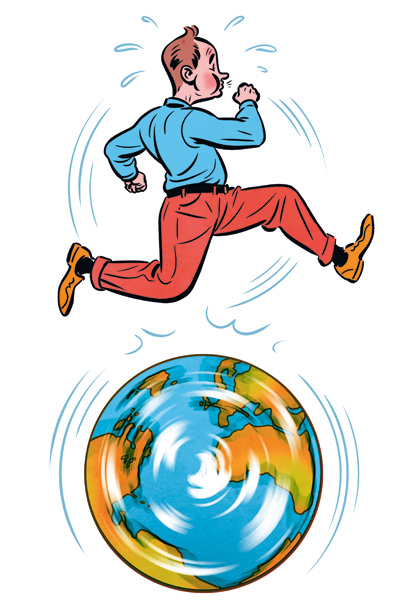The word ‘turboparalysis’, coined by Michael Lind (who has a brilliant piece on the subject in the Spectator Christmas double issue), is paradoxical, even illogical. And yet it is clear, perfect for our times. Lind defines his term as:
‘a prolonged condition of furious motion without movement in any particular direction, a situation in which the engine roars and the wheels spin but the vehicle refuses to move.’
Turboparalysis is a new word; but its sense is familiar. We are often warned that we ‘risk repeating the mistakes of the 1930s’. Comparison between eras is always awkward. Try to compare, for instance, unemployment in Britain during the Great Depression and the Great Recession and you will see contrast: grainy flat caps in a dole queue versus high-definition commuters waiting for a crowded train. Yet the concerns inherent in Lind’s definition match those of the 1930s; anxiety unites the two eras.
Evelyn Waugh came to deride Vile Bodies (1930), his first commercial triumph. In the preface to the 1965 edition, he wrote that the book’s success was the result of modishness at the turn of the decade. But its immediate popularity is, to my mind, a reason for its lasting importance. Vile Bodies is much more than a satire of the Bright Young Things. It expresses something profound about a moment in history; a moment of mounting uncertainty, of the world spinning ever faster; and of people rendered helpless by events, their impotence caused by technological change and the weight of the past as much as by the world economy sinking one too many Manhattans and passing out in 1929.
Its epigraph suggests that Waugh intended those themes to be central. He quoted the following passage from Lewis Caroll’s Through the Looking Glass [1871] (which was widely read by Waugh’s circle in the late ‘20s):
‘Well in our country,’ said Alice, still panting a little, ‘you’d generally get to somewhere else – if you ran very fast for a long time, as we’ve been doing.’
‘A slow sort of country!’ said the Queen. ‘Now, here, you see, it takes all the running you can do, to keep in the same place. If you want to get somewhere else, you must run at least twice as fast as that!’
There are few better accounts of the surreal state of perpetual futile struggle, of turboparalysis, than Caroll’s. Waugh explored this state throughout Vile Bodies, notably when Agatha Runcible is committed after going mad during a motor race. She says:
‘D’you know, all that time when I was dotty I had the most awful dreams. I thought we were all driving round and round in a motor race and none of us could stop, and there was an enormous audience… all shouting to us at once to go faster, and car after car kept crashing until I was left all alone driving and driving – and then I used to crash and wake up.’
The quote also shows Waugh presenting history as repetitious and capricious (the unstoppable cars going round and round before crashing). As Richard Jacobs wrote in his introduction to the Penguin Modern Classics edition of Vile Bodies, ‘the effect suggested is of history (personal, social, political) being on edge, in transition but in strange stasis, about to fall but not falling.’ Now, as then, we appear to be stalled on the edge of history.
History may be momentarily inert; but people still suffer. Perhaps they suffer more. Waugh examined this in Vile Bodies but without the same force as Henry Green in Living (1929). Green has been out of fashion for decades; but Living deserves to stand next to George Orwell’s Down and Out in London and Paris and The Road to Wigan Pier. Inspired by Green’s experience working on the floor of his family’s factory in Birmingham, it is the story of an uncompetitive iron foundry in the 1920s. Green’s cast ranges from the hyperactive but hopeless owner, through the warring managers right down to the granddaughter of the lowliest and most outmoded workman. It is a book about the intense grind of mundane lives.
Christopher Isherwood labelled it ‘the great proletarian novel’, which it probably was during the epoch of proletarians and the bourgeoisie. But from this distance in time, Living is an artefact that depicts the loss of a now lost industrial world. Plot devices such as the introduction of short time at the foundry and the steady cull of workers take their place in our perceptions of the decline and fall of the Workshop of the World. And Green’s picture of hearth and home has become even more poignant in the 80 years since Living was written. One proud mother tells her boy that he’ll be ‘a turner like his dad’. Green’s contemporaries may have doubted that son would follow father; we know that he didn’t. And, of course, we have our own worries about sons following fathers as the Lost Decade rolls on. Elsewhere in Green’s book, two characters, Bert and Lily, want to forge a life out of their love. They consider a career change; they consider moving north; they consider emigrating; nothing comes to pass; they part. Their tragedy is being repeated.
Living and Vile Bodies complement each other, describing a bewildering and costly point in time, a moment very much like our own even if the statistics deny that analysis.






Comments